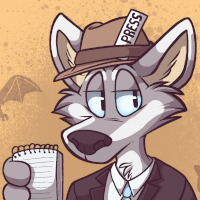Mist, by Amy Fontaine – Book Review by Fred Patten
by Pup Matthias
Submitted by Fred Patten, Furry’s favorite historian and reviewer.
 Mist, by Amy Fontaine
Mist, by Amy Fontaine
Knoxville, TN, Thurston Howl Publications, September 2017, trade paperback, $10.99 (168 [+ 1] pages), Kindle $2.99.
Mist is more like a traditional fairy tale than a usual furry novel.
“‘Where am I?’ said the five children. They startled all at once at the sound of each other’s voices.
They peered at each other through the swirling mist, slowly piecing together each other’s appearance. A broad-shouldered girl with brown eyes as fierce as a hawk’s stood firmly, locking eyes with each of the others in turn and staring them down. A much younger, much smaller girl trembled as she gazed into the mist, twirling a golden curl of hair around her finger. A boy with short-cropped, dirty-blond hair smiled kindly at the others. A tall, lanky boy with messy brown hair glanced all around himself, assessing his surroundings. A pale boy with pointed ears frowned at the others. They all seemed to be teenagers of varying ages, except for the quivering little girl.
‘Who are you?’ the children asked each other.” (p. 1)
The five children do not remember their names. They are in a forest of tall trees shrouded in mist. They find a giant redwood with a treehouse containing shelves of books. A book on a candle-lit table is titled Transformations.
“The book had two parts, ‘Part One: Changing Yourself,’ and ‘Part Two: Changing the World.’” (p. 3)
The five children learn that they each have two animal forms (only one of which is revealed immediately to the reader), and they can all talk telepathically, in their animal or human forms. Since they do not know their names, they take new ones. The hawk-eyed girl, who can become a wolf, becomes Karen Starbroke, their leader. The boy with the gentle smile is Samuel Reed, a red deer. The little girl is Tessa Opal, a golden mongoose. The messy-haired boy is Jack Walsh, a lynx. The pale boy with pointed ears, a python, will not show the others what his other animal form is, and only reluctantly chooses a name when pressed by Karen: Loki Avila.
“‘Well, now that we have that established, we can go and use what we can do to be heroes.’” (p. 5)


 The Book of Dust. Volume 1, La Belle Sauvage, by Philip Pullman. Illustrated by Chris Wormell.
The Book of Dust. Volume 1, La Belle Sauvage, by Philip Pullman. Illustrated by Chris Wormell. Mark of the Tiger’s Stripe, by Joshua Yoder. Maps by the author.
Mark of the Tiger’s Stripe, by Joshua Yoder. Maps by the author. Otters in Space III: Octopus Ascending, by Mary E. Lowd
Otters in Space III: Octopus Ascending, by Mary E. Lowd Oswald the Lucky Rabbit: The Search for the Lost Disney Cartoons, by David A. Bossert. Introduction by J. B. Kaufman. Illustrated.
Oswald the Lucky Rabbit: The Search for the Lost Disney Cartoons, by David A. Bossert. Introduction by J. B. Kaufman. Illustrated. The Lamb Will Slaughter the Lion, by Margaret Killjoy
The Lamb Will Slaughter the Lion, by Margaret Killjoy Passing Through; Tails from the Road [edited by Weasel]
Passing Through; Tails from the Road [edited by Weasel] Imperium Lupi, by Adam Browne. Illustrations, maps by the author.
Imperium Lupi, by Adam Browne. Illustrations, maps by the author. The Art of Aardman: The Makers of Wallace & Gromit, Chicken Run, and More. Foreword by David Sproxton and Peter Lord.
The Art of Aardman: The Makers of Wallace & Gromit, Chicken Run, and More. Foreword by David Sproxton and Peter Lord.
 ROAR volume 8, Paradise, edited by Mary E. Lowd.
ROAR volume 8, Paradise, edited by Mary E. Lowd.